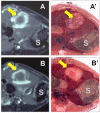Necrosis avidity: a newly discovered feature of hypericin and its preclinical applications in necrosis imaging
- PMID: 24052807
- PMCID: PMC3776218
- DOI: 10.7150/thno.6650
Necrosis avidity: a newly discovered feature of hypericin and its preclinical applications in necrosis imaging
Abstract
Hypericin has been widely studied as a potent photosensitizer for photodynamic therapy in both preclinical and clinical settings. Recently, hypericin has also been discovered to have a specific avidity for necrotic tissue. This affinity is also observed in a series of radiolabeled derivatives of hypericin, including [(123)I]iodohypericin, [(124)I]iodohypericin, and [(131)I]iodohypericin. Hypericin, along with other necrosis-avid contrast agents, has been investigated for use in noninvasively targeting necrotic tissues in numerous disorders. Potential clinical applications of hypericin include the identification of acute myocardial infarction, evaluation of tissue viability, assessment of therapeutic responses to treatments, and interventional procedures for solid tumors. The mechanisms of necrosis avidity in hypericin remain to be fully elucidated, although several hypotheses have been suggested. In particular, it has been proposed that the necrosis avidity of hypericin is compound specific; for instance, cholesterol, phosphatidylserine, or phosphatidylethanolamine components in the phospholipid bilayer of cellular membranes may be the major targets for its observed selectivity. Further investigations are needed to identify the specific binding moiety that is responsible for the necrosis avidity of hypericin.
Keywords: avidity; hypericin; necrosis.
Conflict of interest statement
Competing Interests: The authors have declared that no competing interest exists.
Figures





Similar articles
-
Radiolabeled iodohypericin as tumor necrosis avid tracer: diagnostic and therapeutic potential.Int J Cancer. 2012 Jul 15;131(2):E129-37. doi: 10.1002/ijc.26492. Epub 2012 Jan 11. Int J Cancer. 2012. PMID: 22038886
-
Exploration of the mechanism underlying the tumor necrosis avidity of hypericin.Oncol Rep. 2008 Apr;19(4):921-6. Oncol Rep. 2008. PMID: 18357376
-
Biodegradable Hypericin-Containing Nanoparticles for Necrosis Targeting and Fluorescence Imaging.Mol Pharm. 2020 May 4;17(5):1538-1545. doi: 10.1021/acs.molpharmaceut.9b01238. Epub 2020 Apr 7. Mol Pharm. 2020. PMID: 32212709 Free PMC article.
-
Hypericin--a new antiviral and antitumor photosensitizer: mechanism of action and interaction with biological macromolecules.Curr Drug Targets. 2002 Feb;3(1):55-84. doi: 10.2174/1389450023348091. Curr Drug Targets. 2002. PMID: 11899265 Review.
-
Hypericin in the Light and in the Dark: Two Sides of the Same Coin.Front Plant Sci. 2016 May 6;7:560. doi: 10.3389/fpls.2016.00560. eCollection 2016. Front Plant Sci. 2016. PMID: 27200034 Free PMC article. Review.
Cited by
-
The Necrosis-Avid Small Molecule HQ4-DTPA as a Multimodal Imaging Agent for Monitoring Radiation Therapy-Induced Tumor Cell Death.Front Oncol. 2016 Oct 21;6:221. doi: 10.3389/fonc.2016.00221. eCollection 2016. Front Oncol. 2016. PMID: 27818949 Free PMC article.
-
Improved therapeutic outcomes of thermal ablation on rat orthotopic liver allograft sarcoma models by radioiodinated hypericin induced necrosis targeted radiotherapy.Oncotarget. 2016 Aug 9;7(32):51450-51461. doi: 10.18632/oncotarget.9848. Oncotarget. 2016. PMID: 27285983 Free PMC article.
-
Pre-clinical Evaluation of a Cyanine-Based SPECT Probe for Multimodal Tumor Necrosis Imaging.Mol Imaging Biol. 2016 Dec;18(6):905-915. doi: 10.1007/s11307-016-0972-7. Mol Imaging Biol. 2016. PMID: 27277828 Free PMC article.
-
A novel multimodal nanoplatform for targeting tumor necrosis.RSC Adv. 2021 Sep 15;11(47):29486-29497. doi: 10.1039/d1ra05658a. eCollection 2021 Sep 1. RSC Adv. 2021. PMID: 35479549 Free PMC article.
-
Fluorescence-Guided Laparoscopy after Oral Hypericin Administration for Staging of Locally Advanced Gastric Cancer-A Pilot Study.J Clin Med. 2024 Apr 21;13(8):2422. doi: 10.3390/jcm13082422. J Clin Med. 2024. PMID: 38673695 Free PMC article.
References
-
- Kacerovska D, Pizinger K, Majer F. et al. Photodynamic therapy of nonmelanoma skin cancer with topical hypericum perforatum extract--a pilot study. Photochem Photobiol. 2008;84:779–785. - PubMed
-
- Miskovsky P. Hypericin--a new antiviral and antitumor photosensitizer: mechanism of action and interaction with biological macromolecules. Curr Drug Targets. 2002;3:55–84. - PubMed
-
- Saw CL, Olivo M, Soo KC. et al. Spectroscopic characterization and photobleaching kinetics of hypericin-N-methyl pyrrolidone formulations. Photochem Photobiol Sci. 2006;5:1018–1023. - PubMed
-
- Olivo M, Lau W, Manivasager V. et al. Novel photodynamic diagnosis of bladder cancer: ex vivo fluorescence cytology using hypericin. Int J Oncol. 2003;23:1501–1504. - PubMed
-
- Olivo M, Du HY, Bay BH. Hypericin lights up the way for the potential treatment of nasopharyngeal cancer by photodynamic therapy. Curr Clin Pharmacol. 2006;1:217–222. - PubMed
Publication types
MeSH terms
Substances
LinkOut - more resources
Full Text Sources
Other Literature Sources

